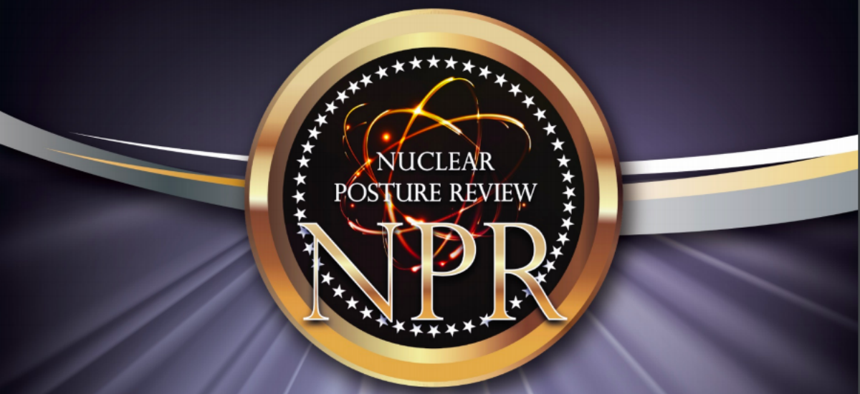
Kevin Baron/Defense One
Nuclear Nuts: Trump's New Policy Hypes The Threat and Brings Us Closer to War
The Pentagon's Nuclear Posture Review only bends reality to fit Trump’s warped views.
Friday afternoon is not usually the time government officials choose to present good news. So, you could sympathize as officials struggled at the Pentagon roll out of President Donald Trump’s controversial new plan for nuclear weapons, called the Nuclear Posture Review, this Friday.
They had reason to try to bury the report. Trump’s plan orders an expensive rebuild of America’s Cold War-era arsenal, adds new weapons and new missions, and breaks with decades of bipartisan strategy.
Ever since Richard Nixon, American presidents have cut the size of the U.S. nuclear arsenal, with Republicans leading the way. After modest reductions by President’s Nixon, Gerald Ford, and Jimmy Carter, the duo of Ronald Reagan and George H. W. Bush cut the number of weapons by a combined 50 percent; Bill Clinton by just over 20 percent and George W. Bush cut another 50 percent. Barack Obama contributed a comparatively modest 24 percent reduction. But all these presidents sought to reduce the role and number of nuclear weapons in U.S. national security strategy.
In part, this represented a climb down from the massive overkill capability developed during the Cold War. We went nuclear nuts at the beginning of the nuclear age, climbing from a few hundred nuclear weapons in 1949 to over 30,000 by the mid-1960’s. Down to about 5,000 today, the United States still has the largest, most flexible, capable nuclear force in the world. No U.S. commander would trade our force for that of another nation. Far in excess of any conceivable military need, the Joint Chiefs of Staff concluded in 2012 that we could cut the force by one-third and still fulfill all required military missions.
Even with such a cut, the Chiefs said, Russia would still not “be able to achieve a military significant advantage by any plausible expansion of its strategic nuclear force, even in a cheating or breakout scenario.” The head of U.S. Strategic Command, Gen. John Hyten, who leads the nuclear force, said just last year that he was “very comfortable with the flexibility of our response options…I actually have a series of very flexible options from conventional all the way up to large-scale nuke that I can advise the president on to give him options.”
But that does not fit with Trump’s view that “our nuclear arsenal has been allowed to atrophy” and “our nuclear weapons don’t work.” So this new posture review bends reality to fit his views. It hypes the threat and presents itself as a calm, measured approach perfectly consistent with past policies. It uses the world “flexible” 29 times, “options” 40 times, “tailored” 30 times and “deterrence” a whopping 191 times to soften the grim destructive strategy it proposes.
Trump exiles arms control to the outermost policy provinces, focusing instead on boosting spending and “the integration of nuclear and non-nuclear military planning.” The military’s combatant commands and service components of Army, Navy, Air Force, and Marines., now “will plan, train, and exercise to integrate U.S. nuclear and non-nuclear forces.” This blurs, then erases, the sharp firebreak previous presidents have kept between conventional weapons most troops use, and nuclear weapons, which few will ever see.
To write his new plan, Trump imported a team of nuclear hawks. “Hawks” may be an understatement. One of the principal authors, Keith Payne, wrote in his 1980 article, “Victory is Possible,” that America should be willing to sacrifice 20 million citizens in a nuclear war. That, he said, was “a level compatible with national survival and recovery.”
Others on the team pushed weapons and policies that triggered a small revolt from the Pentagon brass, according to a report in The American Conservative. As one general put it, by pushing to deploy so-called “low-yield” warheads, “Payne and his team were providing Donald Trump with ‘a kind of gateway drug for nuclear war.’”
Their concerns are well founded. These Dr. Strangelovian strategies have long been a staple of the nuclear policy debates that roil defense journals (and now Twitter). But they have not had a president who might implement them since we proliferated battlefield nukes in the 1950’s.
Now they do. The greatest danger of this plan is that it operationalizes Trump’s worst impulses.
Trump threatens other nations with “fire and fury” and says “Let it be an arms race.” He asks “If we have [nuclear weapons], why can’t we use them?” The new strategy gives him a massive rebuild of the current cold war arsenal, complete with new missions and new weapons. This plan, coupled with this president, greatly increases the risk of nuclear war.
It may take years to see the deployment of the new nuclear weapons proposed — and budget realities may kill much of the buildup. But U.S. nuclear policy changed on Friday. Trump now has a doctrine that would allow him to legally order nuclear strikes in more contingencies, against more targets, for more reasons. The U.S. nuclear stockpile already has over one thousand “low-yield” nuclear weapons, primarily the B-16 air-dropped bomb and the air-launched cruise missile, with yields ranging from 0.3 kilotons to 170 kilotons. He could order their use in Korea, Iran, or anywhere he felt threatened.
And if you believe this plan, we are very threatened. The authors spend pages arguing that the world has grown exponentially more dangerous due to the weakness of Trump’s predecessors. They completely ignore the agreements that decreased Russian arsenals, rolled back and froze Iran’s nuclear program, and eliminated and secured tons of nuclear material from terrorists. The Nuclear Posture Review paints a world of terrifying “Great Power” conflict. With charts that show other nations racing ahead while airbrushing out our substantial modernization programs, the authors try to terrorize the American public into betting heavily on new nuclear arms.
But Americans’ real fears may be closer to home. According to a Washington Post poll over 60 percent of the American public do not trust Trump to make wise decisions on nuclear weapons. About half fear that he will launch a nuclear attack without justification.
This new plan gives them a lot more reason to be worried.
NEXT STORY: Americans Are Rising to This Historic Moment


